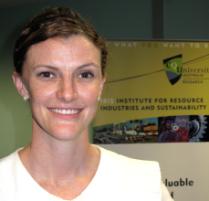Megan is bright Star in environmental economics
Published on 14 December, 2010
Megan Star may have roots in the farming lands of inland New South Wales, but her passion has been captivated by the coastal areas of Central Queensland and the wonders of the Great Barrier Reef.
Life as a primary industries economist has seen the 25-year-old work in some remote rural Australian communities, including the Northern Territory, but in recent years she has called Rockhampton and the Capricorn Coast home.

Megan Star believes counting the dollars makes 'cents' when it comes to looking after the reef.The Department of Primary Industries and Fisheries economist and CQUniversity researcher has developed a love and zeal for the region and its magnificent Great Barrier Reef.
However this love has turned to compassion in recent times as her concern grows for the health of the reef.
She believes excessive sediment loads that are entering the Great Barrier Reef lagoon will continue to have big impacts on coral growth, sea grasses and fish communities.
Research to date has pointed the finger at farming lands as the root of much of the problem, and in finding a solution Ms Star believes Queensland needs to look at economically viable investments in land management.
As the focus of Ms Star's PhD research conducted through CQUniversity, ground cover has been identified as an important factor in reducing sediment loads.
Ms Star said improving ground cover has presented a difficult task for reef stakeholders in the Fitzroy Basin, but she hopes her research may provide the answers for a more sustainable reef catchment.
Ms Star has employed a linear programming model based on paddock scale information in conjunction with land mapping.
"The result is we can identify which land types allow the largest sediment reduction to be achieved at the least cost," Ms Star explained.
"From the five land types modelled, the lower productivity land types present the cheapest option for sediment reductions, and in fact represent a large percentage of the reef catchment."
This research will have big benefits for natural resource management organisations, enabling them to allocate their money in the best way.
Ms Star presented her research to academic, community and industry representatives during the recent IRIS (Institute for Resource Industries and Sustainability) Conference in Rockhampton.

